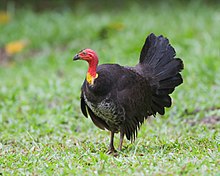Australian brushturkey
| Australian brushturkey | |
|---|---|
 |
|
| Cairns, Queensland | |
| Scientific classification | |
| Kingdom: | Animalia |
| Phylum: | Chordata |
| Class: | Aves |
| Order: | Galliformes |
| Family: | Megapodiidae |
| Genus: |
Alectura Latham, 1824 |
| Species: | A. lathami |
| Binomial name | |
|
Alectura lathami Gray, 1831 |
|
| Subspecies | |
|
|
The Australian brushturkey or Australian brush-turkey (Alectura lathami), also frequently called the scrub turkey or bush turkey, is a common, widespread species of mound-building bird from the family Megapodiidae found in eastern Australia from Far North Queensland to Illawarra in New South Wales. The Australian brushturkey has also been introduced to Kangaroo Island in South Australia. It is the largest extant representative of the family Megapodiidae and is one of three species to inhabit Australia. Despite its name and their superficial similarities, the bird is not closely related to American turkeys, or to the Australian bustard, which is also known as the bush turkey.
It is a large bird with black feathers and a red head. Its total length is about 60–75 cm (23.5–29.5 in) and a wingspan of about 85 cm (33 in). The subspecies A. l. purpureicollis from the northern Cape York Peninsula is smaller than the more widespread nominate subspecies. It has a prominent, fan-like tail flattened sideways, and its plumage is mainly blackish, but with a bare red head, and a yellow (in the nominate subspecies) or purple wattle (in A. l. purpureicollis). The male's wattle becomes much larger during breeding season, often swinging from side to side as they run. The males' heads and wattles also become much brighter during the breeding and nesting season. The underside of the body is sprinkled with white feathers, more pronounced in older birds. The brushturkey is a clumsy flier and cannot fly long distances, only taking to the air when threatened by predators or to roost in trees at night and during the heat of the day.
They build large nests on the ground made of leaves, other combustible material and earth, 1 to 1.5 metres high (3-4.5 ft) and up to 4 m (13 ft) across. Mound-building is done by a dominant male, and visited by a succession of local females, for mating and egg-laying. The male works tirelessly, collecting material from all around, and also diligently repelling rival males, who are keen to usurp his position. The effort involved eventually wears him down, and he will ultimately be defeated by a new king. The eggs are very large (90mm X 45mm), and the young are fully-fledged on hatching. They can fly within hours, as soon as the feathers are dry. The eggs are hatched by the heat of the composting mound, the temperature of which is regulated by adding or removing material to maintain the temperature in the 33–35 °C (91–95 °F) incubation temperature range. The Australian brushturkey checks the temperature by sticking its beak into the mound. Like some reptiles, incubation temperature affects the sex ratio of chicks, however, the mechanism is different between reptiles and these birds, with reptiles exhibiting Temperature-dependent sex determination (TSD), and megapodes exhibiting temperature-dependent embryo mortality. The sex ratio in brushturkeys is equal at incubation temperatures of 34 °C, but results in more males when cooler and more females when warmer (p=0.035). It is unclear whether the parents use this to manipulate the sex of their offspring by, for instance, selecting the nesting site accordingly. Warmer incubation also results in heavier, fitter chicks (p<<0.0001), but how this is linked to gender is also unknown.
...
Wikipedia

